(一)选题背景:
1.生物多样性保护:鸟类是地球上最为丰富和多样的脊椎动物类群之一,对于生态系统的稳定和生物多样性的维持起着重要作用。通过开展鸟类图像分类研究,可以帮助精确地辨别鸟类物种,有助于监测鸟类的分布、数量和迁徙情况,从而更好地实施生物多样性保护和生态环境管理。2.环境监测和生态学研究:鸟类在各种不同的生态系统中都占据着特定的生态角色,其物种组成和数量分布可以反映出环境质量和生态系统变化。通过对鸟类图像进行分类和监测,可以在大尺度上了解不同地区的生态系统状态、环境变化以及人类活动对生态系统的影响。
3.计算机视觉和深度学习研究:鸟类图像分类是计算机视觉领域的经典问题,涉及图像分割、特征提取、对象识别和模式识别等技术。通过开展鸟类图像分类研究,可以推动计算机视觉和深度学习在实际场景中的应用和发展,促进相关算法和模型的优化和改进。
数据集来源:kaggle,网址:https://www.kaggle.com/
(二)机器学习的实现步骤
1.数据集下载


2.导入需要用到的库
1 import warnings 2 from sklearn.exceptions import ConvergenceWarning 3 warnings.filterwarnings("ignore", category=ConvergenceWarning) 4 warnings.simplefilter(action='ignore', category=FutureWarning) 5 warnings.simplefilter(action='ignore', category=UserWarning) 6 7 import itertools 8 import numpy as np 9 import pandas as pd 10 import os 11 import matplotlib.pyplot as plt 12 from sklearn.preprocessing import LabelEncoder 13 from sklearn.model_selection import train_test_split 14 from PIL import Image 15 from sklearn.metrics import classification_report, f1_score , confusion_matrix 16 17 18 19 # Tensorflow库 20 import tensorflow as tf 21 from tensorflow import keras 22 from keras.layers import Dense, Dropout , BatchNormalization 23 from tensorflow.keras.optimizers import Adam 24 from tensorflow.keras import layers,models,Model 25 from keras.preprocessing.image import ImageDataGenerator 26 from tensorflow.keras.layers.experimental import preprocessing 27 from tensorflow.keras.callbacks import Callback, EarlyStopping, ModelCheckpoint, ReduceLROnPlateau 28 from tensorflow.keras import mixed_precision 29 mixed_precision.set_global_policy('mixed_float16') 30 31 32 print(tf.__version__)

3.加载数据
1 # 定义数据集路径 2 dataset = { 3 "train_data" : "./lty/input/bird-species/train", 4 "valid_data" : "./lty/input/bird-species/valid", 5 "test_data" : "./lty/input/bird-species/test" 6 } 7 8 all_data = [] 9 10 # 遍历数据集文件夹并读取图片和标签信息 11 for path in dataset.values(): 12 data = {"imgpath": [] , "labels": [] } 13 category = os.listdir(path) 14 15 for folder in category: 16 folderpath = os.path.join(path , folder) 17 filelist = os.listdir(folderpath) 18 for file in filelist: 19 fpath = os.path.join(folderpath, file) 20 data["imgpath"].append(fpath) 21 data["labels"].append(folder) 22 23 # 将数据加入列表中 24 all_data.append(data.copy()) 25 data.clear() 26 27 # 将列表转化为DataFrame格式 28 train_df = pd.DataFrame(all_data[0] , index=range(len(all_data[0]['imgpath']))) 29 valid_df = pd.DataFrame(all_data[1] , index=range(len(all_data[1]['imgpath']))) 30 test_df = pd.DataFrame(all_data[2] , index=range(len(all_data[2]['imgpath']))) 31 32 # 将标签转化为数字编码 33 lb = LabelEncoder() 34 train_df['encoded_labels'] = lb.fit_transform(train_df['labels']) 35 valid_df['encoded_labels'] = lb.fit_transform(valid_df['labels']) 36 test_df['encoded_labels'] = lb.fit_transform(test_df['labels'])
1 # 获取训练集中每个类别的图像数量和标签 2 train = train_df["labels"].value_counts() 3 label = train.tolist() 4 index = train.index.tolist() 5 6 # 设置颜色列表 7 colors = [ 8 "#1f77b4", "#ff7f0e", "#2ca02c", "#d62728", "#9467bd", 9 "#8c564b", "#e377c2", "#7f7f7f", "#bcbd22", "#17becf", 10 "#aec7e8", "#ffbb78", "#98df8a", "#ff9896", "#c5b0d5", 11 "#c49c94", "#f7b6d2", "#c7c7c7", "#dbdb8d", "#9edae5", 12 "#5254a3", "#6b6ecf", "#bdbdbd", "#8ca252", "#bd9e39", 13 "#ad494a", "#8c6d31", "#6b6ecf", "#e7ba52", "#ce6dbd", 14 "#9c9ede", "#cedb9c", "#de9ed6", "#ad494a", "#d6616b", 15 "#f7f7f7", "#7b4173", "#a55194", "#ce6dbd" 16 ] 17 18 # 绘制水平条形图 19 plt.figure(figsize=(30,30)) 20 plt.title("Training data images count per class",fontsize=38) 21 plt.xlabel('Number of images', fontsize=35) 22 plt.ylabel('Classes', fontsize=35) 23 plt.barh(index,label, color=colors) 24 plt.grid(True) 25 plt.show()

1 # 从训练集中随机选择15个样本 2 train_df.sample(n=15, random_state=1)

1 import os 2 3 # 设置训练集文件夹路径 4 path = "C:/Users/z/lty/bird-species/train" 5 6 # 获取train训练集文件夹列表 7 dirs = os.listdir(path) 8 9 # 遍历文件夹列表并打印文件名 10 for file in dirs: 11 print(file)

1 # 打印训练集信息 2 print("----------Train-------------") 3 print(train_df[["imgpath", "labels"]].head(5)) # 打印前5行的图像路径和标签 4 print(train_df.shape) # 打印训练集的形状,即行数和列数 5 6 # 打印验证集信息 7 print("--------Validation----------") 8 print(valid_df[["imgpath", "labels"]].head(5)) # 打印前5行的图像路径和标签 9 print(valid_df.shape) # 打印验证集的形状,即行数和列数 10 11 # 打印测试集信息 12 print("----------Test--------------") 13 print(test_df[["imgpath", "labels"]].head(5)) # 打印前5行的图像路径和标签 14 print(test_df.shape) # 打印测试集的形状,即行数和列数
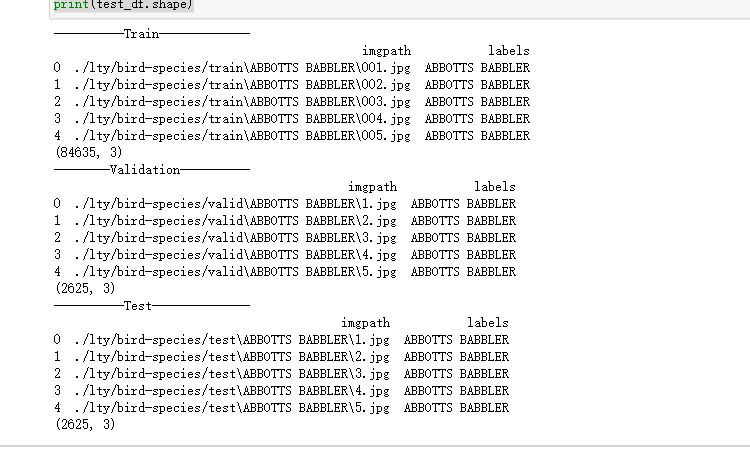
4.展示数据的样本
1 import matplotlib.pyplot as plt 2 from PIL import Image 3 4 # 创建一个大小为15x12的画布 5 plt.figure(figsize=(15, 12)) 6 7 # 从验证集中随机选择16个样本,重置索引并逐行处理 8 for i, row in valid_df.sample(n=16).reset_index().iterrows(): 9 # 在4x4的子图中的第i+1个位置创建一个子图 10 plt.subplot(4, 4, i+1) 11 12 # 获取图像路径 13 image_path = row['imgpath'] 14 15 image = Image.open(image_path) 16 17 plt.imshow(image) 18 19 # 设置子图的标题为标签值 20 plt.title(row["labels"]) 21 22 plt.axis('off') 23 plt.show()
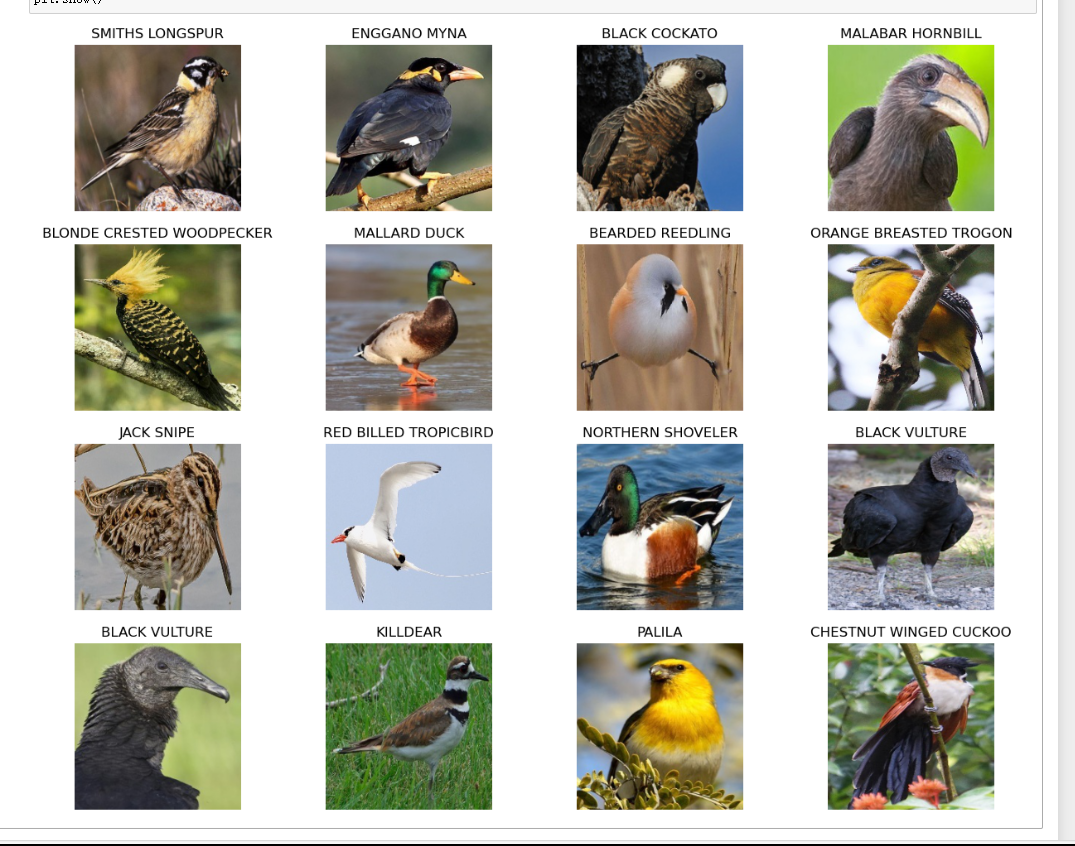
5.创建数据加载器(Dataloaders)
1 %%time 2 3 BATCH_SIZE = 35 4 IMAGE_SIZE = (224, 224) 5 6 # 导入图像数据生成器 ImageDataGenerator 7 from keras.preprocessing.image import ImageDataGenerator 8 9 # 定义数据增强生成器 10 generator = ImageDataGenerator( 11 preprocessing_function=tf.keras.applications.efficientnet.preprocess_input, # 预处理函数 12 rescale=1./255, # 将像素值缩放到0-1之间 13 width_shift_range=0.2, # 水平和垂直方向上的随机平移范围 14 height_shift_range=0.2, 15 zoom_range=0.2 # 随机缩放图像的范围 16 ) 17 18 # 将训练集数据分批生成并进行数据增强 19 train_images = generator.flow_from_dataframe( 20 dataframe=train_df, # 使用train_df作为数据源 21 x_col='imgpath', # 图像路径的列名 22 y_col='labels', # 标签的列名 23 target_size=IMAGE_SIZE, # 图像的目标大小 24 color_mode='rgb', # 图像的颜色通道模式 25 class_mode='categorical', # 分类模式,输出是一个one-hot编码的向量 26 batch_size=BATCH_SIZE, # 批次大小 27 shuffle=True, # 是否打乱数据顺序 28 seed=42 # 随机种子 29 ) 30 31 # 将验证集数据分批生成 32 val_images = generator.flow_from_dataframe( 33 dataframe=valid_df, # 使用valid_df作为数据源 34 x_col='imgpath', 35 y_col='labels', 36 target_size=IMAGE_SIZE, 37 color_mode='rgb', 38 class_mode='categorical', 39 batch_size=BATCH_SIZE, 40 shuffle=False 41 ) 42 43 # 将测试集数据分批生成 44 test_images = generator.flow_from_dataframe( 45 dataframe=test_df, # 使用test_df作为数据源 46 x_col='imgpath', 47 y_col='labels', 48 target_size=IMAGE_SIZE, 49 color_mode='rgb', 50 class_mode='categorical', 51 batch_size=BATCH_SIZE, 52 shuffle=False 53 )

1 train_images[0][0].shape

1 img= train_images[0] 2 print(img)

1 type(train_images)

1 img = train_images[0] 2 print(img[0].shape) 3 print(img[1].shape)

1 labels = [k for k in train_images.class_indices] 2 sample_images = train_images.__next__() 3 4 images = sample_generate[0] 5 titles = sample_generate[1] 6 plt.figure(figsize = (15 , 15)) 7 8 for i in range(20): 9 plt.subplot(5 , 5 , i+1) 10 plt.subplots_adjust(hspace = 0.3 , wspace = 0.3)#调整子图之间的空白区域 11 plt.imshow(images[i]) 12 plt.title(f'Class: {labels[np.argmax(titles[i],axis=0)]}') 13 plt.axis("off")
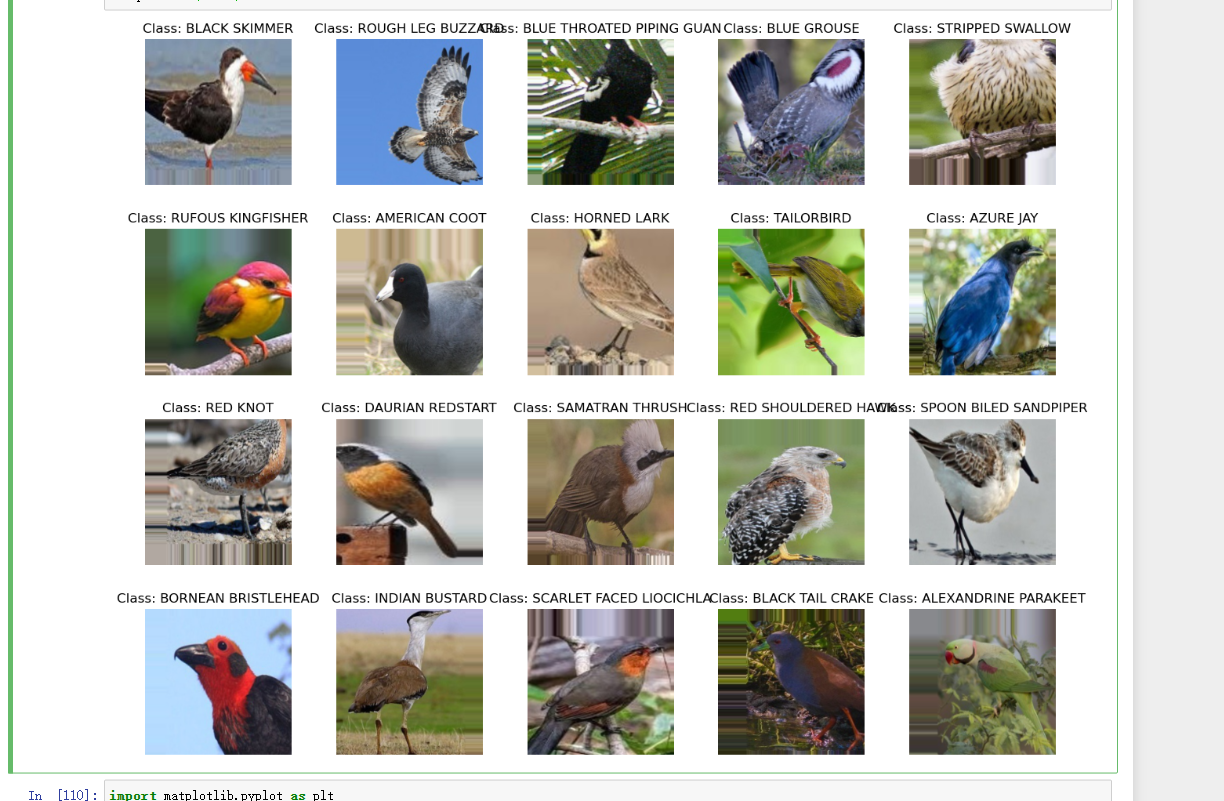
1 import matplotlib.pyplot as plt 2 from skimage import io 3 4 img_url = "./lty/bird-species/train/AFRICAN PIED HORNBILL/007.jpg"#指定要读取和显示的图像文件路径 5 img = io.imread(img_url)#imread函数以数组形式读取指定路径下的图像文件 6 7 plt.imshow(img) 8 plt.axis('off') 9 plt.show()

1 # 加载预训练模型 2 pretrained_model = tf.keras.applications.EfficientNetB5( 3 input_shape=(224, 224, 3), 4 include_top=False, # 不加载或重新初始化顶层(输出层)的参数 5 weights='imagenet', 6 pooling='max' 7 ) 8 9 # 冻结预训练神经网络的层 10 for i, layer in enumerate(pretrained_model.layers): 11 pretrained_model.layers[i].trainable = False

1 # 获取类别数 2 num_classes = len(set(train_images.classes)) 3 4 # 对数据进行增强 5 augment = tf.keras.Sequential([ 6 layers.experimental.preprocessing.RandomFlip("horizontal"), 7 layers.experimental.preprocessing.RandomRotation(0.15), 8 layers.experimental.preprocessing.RandomZoom(0.12), 9 layers.experimental.preprocessing.RandomContrast(0.12), 10 ], name='AugmentationLayer') 11 12 # 输入层 13 inputs = layers.Input(shape=(224, 224, 3), name='inputLayer') 14 x = augment(inputs) # 应用数据增强 15 pretrain_out = pretrained_model(x, training=False) 16 17 # 添加全连接层和激活函数 18 x = layers.Dense(1024)(pretrain_out) 19 x = layers.Activation(activation="relu")(x) 20 x = BatchNormalization()(x) 21 x = layers.Dropout(0.45)(x) 22 x = layers.Dense(512)(x) 23 x = layers.Activation(activation="relu")(x) 24 x = BatchNormalization()(x) 25 x = layers.Dropout(0.3)(x) 26 x = layers.Dense(num_classes)(x) 27 outputs = layers.Activation(activation="softmax", dtype=tf.float32, name='activationLayer')(x) 28 29 # 创建模型 30 model = Model(inputs=inputs, outputs=outputs) 31 32 # 编译模型 33 model.compile( 34 optimizer=Adam(0.0005), 35 loss='categorical_crossentropy', 36 metrics=['accuracy'] 37 ) 38 39 # 打印模型结构摘要 40 print(model.summary())
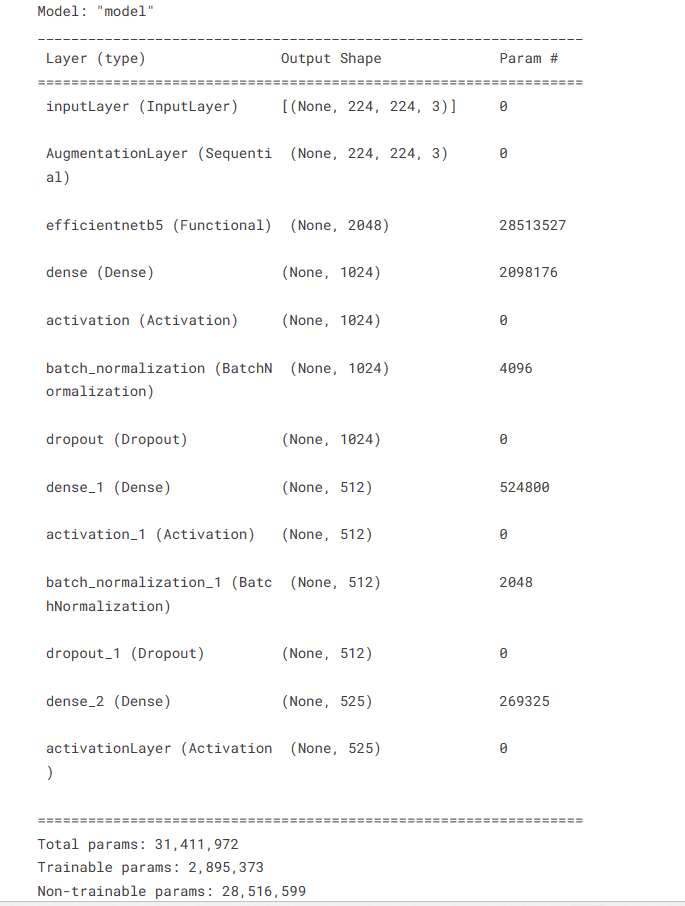
6.预训练模型
在 transfer learning 中,我们可以选择保持预训练模型的一部分或全部参数不变(称为冻结),只对最后几层或某些层进行微调,以适应新任务的特定要求。这样做的原因是预训练模型已经学习到了通用的特征,我们可以认为这些特征对于新任务也是有用的。通过仅微调少量参数,我们可以在较小的数据集上快速训练出具有良好性能的模型。
1 # 训练模型 2 history = model.fit( 3 train_images, 4 steps_per_epoch=len(train_images), 5 validation_data=val_images, 6 validation_steps=len(val_images), 7 epochs=10, 8 callbacks=[ 9 # 提前停止回调,如果验证集损失在连续3个epoch中没有改善,则提前停止训练 10 EarlyStopping(monitor="val_loss", patience=3, restore_best_weights=True), 11 # 学习率调整,在验证集损失没有改善时降低学习率 12 ReduceLROnPlateau(monitor='val_loss', factor=0.2, patience=2, mode='min') 13 ] 14 ) 15 16 # 保存模型权重 17 model.save_weights('./lty/input/bird-species/my_checkpoint')
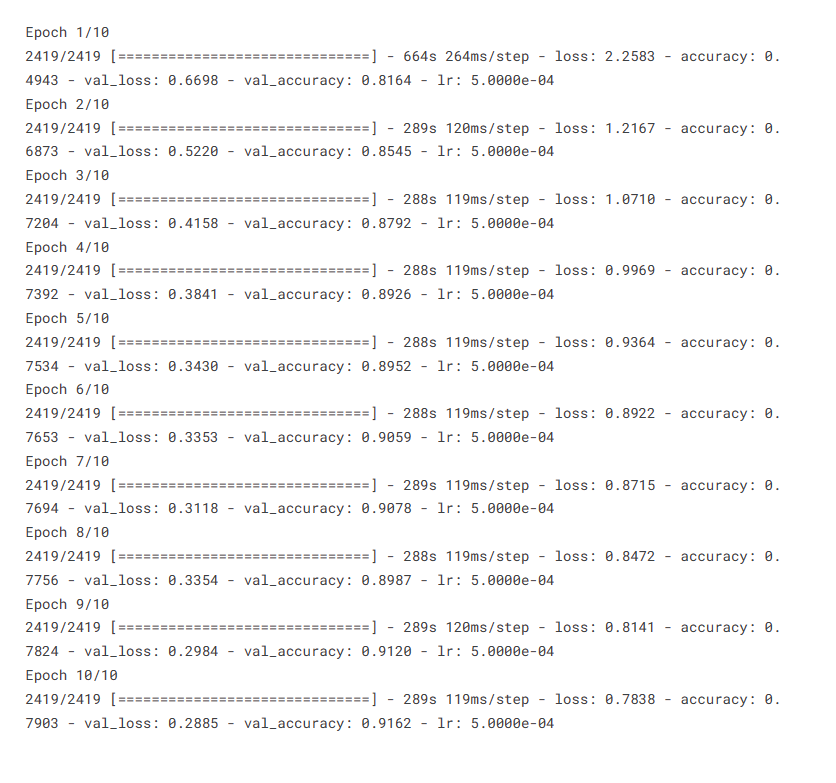
7.模型的性能
1 # 定义所需变量 2 tr_acc = history.history['accuracy'] # 训练准确率 3 tr_loss = history.history['loss'] # 训练损失 4 val_acc = history.history['val_accuracy'] # 验证准确率 5 val_loss = history.history['val_loss'] # 验证损失 6 index_loss = np.argmin(val_loss) # 最小验证损失的索引 7 val_lowest = val_loss[index_loss] # 最小验证损失 8 index_acc = np.argmax(val_acc) # 最大验证准确率的索引 9 acc_highest = val_acc[index_acc] # 最大验证准确率 10 Epochs = [i+1 for i in range(len(tr_acc))] # 训练轮数 11 loss_label = f'best epoch= {str(index_loss + 1)}' # 最小验证损失的标签 12 acc_label = f'best epoch= {str(index_acc + 1)}' # 最大验证准确率的标签 13 14 # 绘制训练历史图表 15 plt.figure(figsize=(20, 8)) 16 plt.style.use('fivethirtyeight') 17 18 plt.subplot(1, 2, 1) 19 plt.plot(Epochs, tr_loss, 'r', label='Training loss') # 绘制训练损失曲线 20 plt.plot(Epochs, val_loss, 'g', label='Validation loss') # 绘制验证损失曲线 21 plt.scatter(index_loss + 1, val_lowest, s=150, c='blue', label=loss_label) # 标记最小验证损失点 22 plt.title('Training and Validation Loss') 23 plt.xlabel('Epochs') 24 plt.ylabel('Loss') 25 plt.legend() 26 27 plt.subplot(1, 2, 2) 28 plt.plot(Epochs, tr_acc, 'r', label='Training Accuracy') # 绘制训练准确率曲线 29 plt.plot(Epochs, val_acc, 'g', label='Validation Accuracy') # 绘制验证准确率曲线 30 plt.scatter(index_acc + 1, acc_highest, s=150, c='blue', label=acc_label) # 标记最大验证准确率点 31 plt.title('Training and Validation Accuracy') 32 plt.xlabel('Epochs') 33 plt.ylabel('Accuracy') 34 plt.legend() 35 36 plt.tight_layout() 37 plt.show()
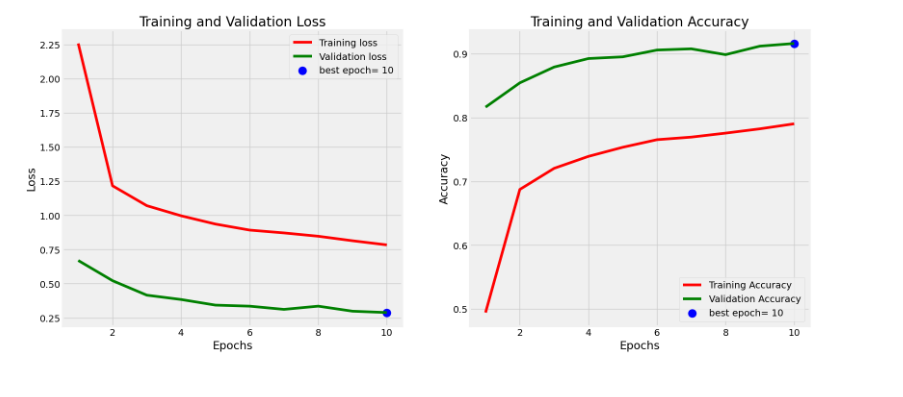
8.对预训练模型进行微调
1 pretrained_model.trainable = True 2 for layer in pretrained_model.layers: 3 if isinstance(layer, layers.BatchNormalization): # 将 BatchNorm 层设置为不可训练,冻结 BatchNorm 层的参数 4 layer.trainable = False 5 6 # 查看深度学习模型的前 10 层 7 for l in pretrained_model.layers[:10]: 8 print(l.name, l.trainable) 9 10 model.compile( 11 optimizer=Adam(0.00001), # 使用小学习率进行微调 12 loss='categorical_crossentropy', 13 metrics=['accuracy'] 14 ) 15 # model.load_weights('./lty/bird-species/my_checkpoint') 16 print(model.summary()) 17 history = model.fit( 18 train_images, 19 steps_per_epoch=len(train_images), 20 validation_data=val_images, 21 validation_steps=len(val_images), 22 epochs=20, 23 callbacks=[ 24 EarlyStopping(monitor = "val_loss", # 观察验证集的损失指标 25 patience = 5, 26 restore_best_weights = True), # if val loss decreases for 5 epochs in a row, stop training, 27 ReduceLROnPlateau(monitor='val_loss', factor=0.2, patience=2, mode='min') 28 ] 29 ) 30 model.save_weights('./lty/bird-species/my_checkpoint')

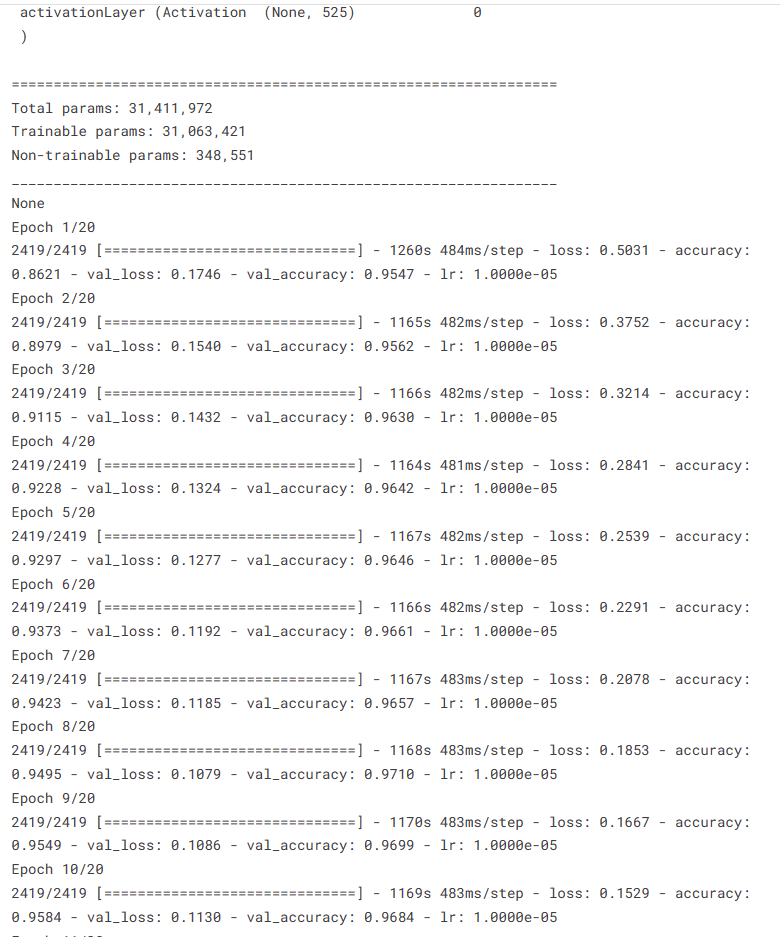
1 # 定义所需的变量 2 tr_acc = history.history['accuracy'] 3 tr_loss = history.history['loss'] 4 val_acc = history.history['val_accuracy'] 5 val_loss = history.history['val_loss'] 6 index_loss = np.argmin(val_loss) 7 val_lowest = val_loss[index_loss] 8 index_acc = np.argmax(val_acc) 9 acc_highest = val_acc[index_acc] 10 Epochs = [i+1 for i in range(len(tr_acc))] 11 loss_label = f'best epoch= {str(index_loss + 1)}' 12 acc_label = f'best epoch= {str(index_acc + 1)}' 13 14 # 绘制训练历史 15 plt.figure(figsize= (20, 8)) 16 plt.style.use('fivethirtyeight') 17 18 plt.subplot(1, 2, 1) 19 plt.plot(Epochs, tr_loss, 'r', label= 'Training loss') 20 plt.plot(Epochs, val_loss, 'g', label= 'Validation loss') 21 plt.scatter(index_loss + 1, val_lowest, s= 150, c= 'blue', label= loss_label) 22 plt.title('Training and Validation Loss') 23 plt.xlabel('Epochs') 24 plt.ylabel('Loss') 25 plt.legend() 26 27 plt.subplot(1, 2, 2) 28 plt.plot(Epochs, tr_acc, 'r', label= 'Training Accuracy') 29 plt.plot(Epochs, val_acc, 'g', label= 'Validation Accuracy') 30 plt.scatter(index_acc + 1 , acc_highest, s= 150, c= 'blue', label= acc_label) 31 plt.title('Training and Validation Accuracy') 32 plt.xlabel('Epochs') 33 plt.ylabel('Accuracy') 34 plt.legend() 35 36 plt.tight_layout 37 plt.show()
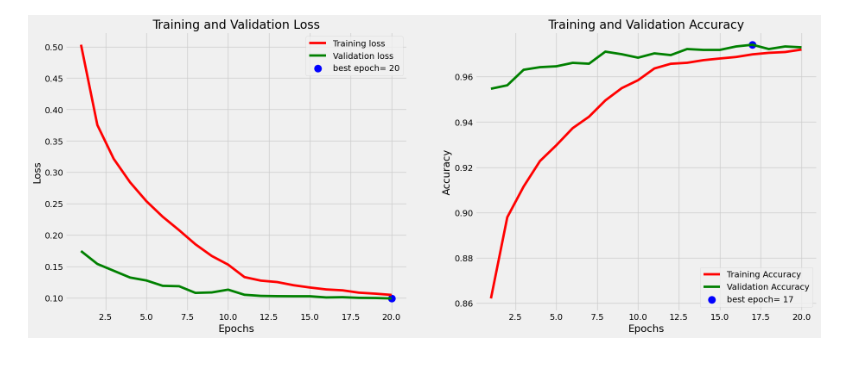
9.评估模型在给定数据集上的性能
1 results = model.evaluate(test_images, verbose=0) 2 # 对测试集进行评估,返回测试损失和测试准确率 3 4 print(" Test Loss: {:.5f}".format(results[0])) 5 # 打印测试损失,保留小数点后5位 6 print("Test Accuracy: {:.2f}%".format(results[1] * 100)) 7 # 打印测试准确率,乘以100后保留两位小数

1 y_true = test_images.classes # 获取测试集样本的真实标签 2 y_pred = np.argmax(model.predict(test_images), axis=1) 3 # 获取模型对测试集样本的预测标签 4 5 # 计算并打印F1 Score和分类报告 6 f1 = f1_score(y_true, y_pred, average='macro') # 计算F1 Score 7 print("F1 Score:", f1) 8 print(classification_report(y_true, y_pred, target_names=test_images.class_indices.keys())) # 打印分类报告
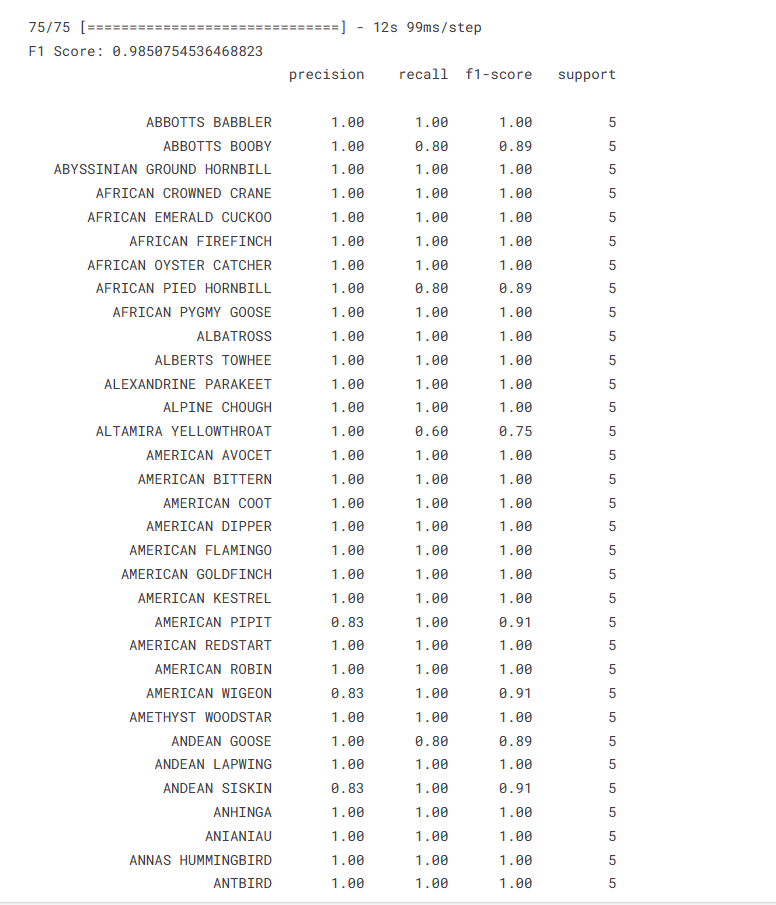
10.获取预测结果
1 # 创建一个字典,将类别索引和对应的类别名称进行关联 2 classes = dict(zip(test_images.class_indices.values(), test_images.class_indices.keys())) 3 4 # 创建一个DataFrame来存储预测结果 5 Predictions = pd.DataFrame({ 6 "Image Index": list(range(len(test_images.labels))), # 图像索引 7 "Test Labels": test_images.labels, # 真实标签 8 "Test Classes": [classes[i] for i in test_images.labels], # 真实类别 9 "Prediction Labels": y_pred, # 预测标签 10 "Prediction Classes": [classes[i] for i in y_pred], # 预测类别 11 "Path": test_images.filenames, # 图像路径 12 "Prediction Probability": [x for x in np.asarray(tf.reduce_max(model.predict(test_images), axis=1))] # 预测概率 13 }) 14 15 Predictions.head(8) # 输出前8行预测结果

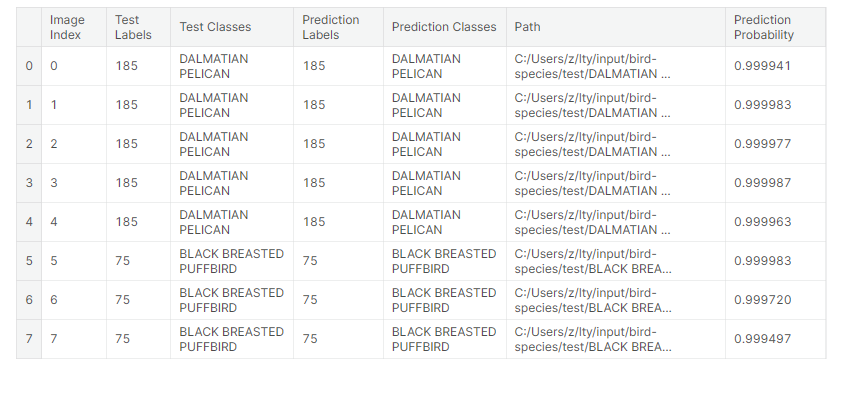
11.在测试数据集上预测错误且置信度最高的样本
1 plt.figure(figsize=(20, 20)) 2 # 选择分类错误的预测结果中概率最高的20个样本 3 subset = Predictions[Predictions["Test Labels"] != Predictions["Prediction Labels"]].sort_values("Prediction Probability").tail(20).reset_index() 4 5 for i, row in subset.iterrows(): 6 plt.subplot(5, 4, i+1) 7 image_path = row['Path'] 8 image = Image.open(image_path) 9 # 显示图像 10 plt.imshow(image) 11 # 设置图像标题,包括真实类别和预测类别 12 plt.title(f'TRUE: {row["Test Classes"]} | PRED: {row["Prediction Classes"]}', fontsize=8) 13 plt.axis('off') 14 15 plt.show()

13. 评估分类模型性能
混淆矩阵(Confusion Matrix)和分类报告(Classification Report)
1 import numpy as np 2 from sklearn.metrics import confusion_matrix 3 import itertools 4 import matplotlib.pyplot as plt 5 6 # 使用模型对测试图片进行预测 7 preds = model.predict_generator(test_images) 8 # 找到每个预测结果中概率最高的类别作为预测标签 9 y_pred = np.argmax(preds, axis=1) 10 11 # 获取测试图片的真实标签和对应的类别字典 12 g_dict = test_images.class_indices 13 # 创建一个包含所有类别名称的列表 14 classes = list(g_dict.keys()) 15 16 # 计算混淆矩阵 17 cm = confusion_matrix(test_images.classes, y_pred) 18 19 plt.figure(figsize=(30, 30)) 20 plt.imshow(cm, interpolation='nearest', cmap=plt.cm.Blues) 21 plt.title('Confusion Matrix') 22 plt.colorbar() 23 24 tick_marks = np.arange(len(classes)) 25 plt.xticks(tick_marks, classes, rotation=45) 26 plt.yticks(tick_marks, classes) 27 28 thresh = cm.max() / 2. 29 for i, j in itertools.product(range(cm.shape[0]), range(cm.shape[1])): 30 plt.text(j, i, cm[i, j], horizontalalignment='center', color='white' if cm[i, j] > thresh else 'black') 31 32 plt.tight_layout() 33 plt.ylabel('True Label') 34 plt.xlabel('Predicted Label') 35 36 plt.show()
使用matplotlib库绘制了一个大小为30x30的图像窗口,显示了混淆矩阵的热力图。热力图的颜色越深,表示预测结果越准确。图像中的数字表示每个混淆矩阵单元格中的样本数量。图像上方的标题为"Confusion Matrix",颜色条表示每个颜色对应的样本数量范围。x轴标签为预测标签,y轴标签为真实标签。
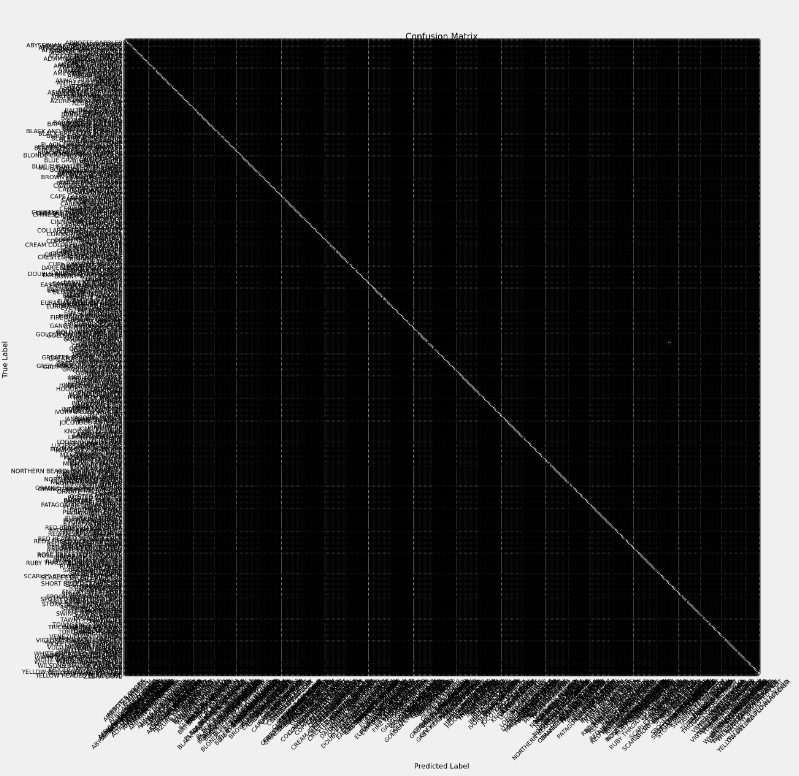
总代码
1 import warnings 2 from sklearn.exceptions import ConvergenceWarning 3 warnings.filterwarnings("ignore", category=ConvergenceWarning) 4 warnings.simplefilter(action='ignore', category=FutureWarning) 5 warnings.simplefilter(action='ignore', category=UserWarning) 6 7 # 导入必要的库 8 import itertools 9 import numpy as np 10 import pandas as pd 11 import os 12 import matplotlib.pyplot as plt 13 from sklearn.preprocessing import LabelEncoder 14 from sklearn.model_selection import train_test_split 15 from PIL import Image 16 from sklearn.metrics import classification_report, f1_score , confusion_matrix 17 18 # 导入TensorFlow库 19 import tensorflow as tf 20 from tensorflow import keras 21 from keras.layers import Dense, Dropout , BatchNormalization 22 from tensorflow.keras.optimizers import Adam 23 from tensorflow.keras import layers,models,Model 24 from keras.preprocessing.image import ImageDataGenerator 25 from tensorflow.keras.layers.experimental import preprocessing 26 from tensorflow.keras.callbacks import Callback, EarlyStopping, ModelCheckpoint, ReduceLROnPlateau 27 from tensorflow.keras import mixed_precision 28 mixed_precision.set_global_policy('mixed_float16') 29 30 # 输出TensorFlow版本 31 print(tf.__version__) 32 33 34 # 定义数据集路径 35 dataset = { 36 "train_data" : "./lty/input/bird-species/train", 37 "valid_data" : "./lty/input/bird-species/valid", 38 "test_data" : "./lty/input/bird-species/test" 39 } 40 41 all_data = [] 42 43 # 遍历数据集文件夹并读取图片和标签信息 44 for path in dataset.values(): 45 data = {"imgpath": [] , "labels": [] } 46 category = os.listdir(path) 47 48 for folder in category: 49 folderpath = os.path.join(path , folder) 50 filelist = os.listdir(folderpath) 51 for file in filelist: 52 fpath = os.path.join(folderpath, file) 53 data["imgpath"].append(fpath) 54 data["labels"].append(folder) 55 56 # 将数据加入列表中 57 all_data.append(data.copy()) 58 data.clear() 59 60 # 将列表转化为DataFrame格式 61 train_df = pd.DataFrame(all_data[0] , index=range(len(all_data[0]['imgpath']))) 62 valid_df = pd.DataFrame(all_data[1] , index=range(len(all_data[1]['imgpath']))) 63 test_df = pd.DataFrame(all_data[2] , index=range(len(all_data[2]['imgpath']))) 64 65 # 将标签转化为数字编码 66 lb = LabelEncoder() 67 train_df['encoded_labels'] = lb.fit_transform(train_df['labels']) 68 valid_df['encoded_labels'] = lb.fit_transform(valid_df['labels']) 69 test_df['encoded_labels'] = lb.fit_transform(test_df['labels']) 70 71 # 获取训练集中每个类别的图像数量和标签 72 train = train_df["labels"].value_counts() 73 label = train.tolist() 74 index = train.index.tolist() 75 76 # 设置颜色列表 77 colors = [ 78 "#1f77b4", "#ff7f0e", "#2ca02c", "#d62728", "#9467bd", 79 "#8c564b", "#e377c2", "#7f7f7f", "#bcbd22", "#17becf", 80 "#aec7e8", "#ffbb78", "#98df8a", "#ff9896", "#c5b0d5", 81 "#c49c94", "#f7b6d2", "#c7c7c7", "#dbdb8d", "#9edae5", 82 "#5254a3", "#6b6ecf", "#bdbdbd", "#8ca252", "#bd9e39", 83 "#ad494a", "#8c6d31", "#6b6ecf", "#e7ba52", "#ce6dbd", 84 "#9c9ede", "#cedb9c", "#de9ed6", "#ad494a", "#d6616b", 85 "#f7f7f7", "#7b4173", "#a55194", "#ce6dbd" 86 ] 87 88 # 绘制水平条形图 89 plt.figure(figsize=(30,30)) 90 plt.title("Training data images count per class",fontsize=38) 91 plt.xlabel('Number of images', fontsize=35) 92 plt.ylabel('Classes', fontsize=35) 93 plt.barh(index,label, color=colors) 94 plt.grid(True) 95 plt.show() 96 97 98 # 从训练集中随机选择15个样本 99 train_df.sample(n=15, random_state=1) 100 101 102 import os 103 104 # 设置训练集文件夹路径 105 path = "C:/Users/z/lty/bird-species/train" 106 107 # 获取train训练集文件夹列表 108 dirs = os.listdir(path) 109 110 # 遍历文件夹列表并打印文件名 111 for file in dirs: 112 print(file) 113 114 115 # 打印训练集信息 116 print("----------Train-------------") 117 print(train_df[["imgpath", "labels"]].head(5)) # 打印前5行的图像路径和标签 118 print(train_df.shape) # 打印训练集的形状,即行数和列数 119 120 # 打印验证集信息 121 print("--------Validation----------") 122 print(valid_df[["imgpath", "labels"]].head(5)) # 打印前5行的图像路径和标签 123 print(valid_df.shape) # 打印验证集的形状,即行数和列数 124 125 # 打印测试集信息 126 print("----------Test--------------") 127 print(test_df[["imgpath", "labels"]].head(5)) # 打印前5行的图像路径和标签 128 print(test_df.shape) # 打印测试集的形状,即行数和列数 129 130 import matplotlib.pyplot as plt 131 from PIL import Image 132 133 # 创建一个大小为15x12的画布 134 plt.figure(figsize=(15, 12)) 135 136 # 从验证集中随机选择16个样本,重置索引并逐行处理 137 for i, row in valid_df.sample(n=16).reset_index().iterrows(): 138 # 在4x4的子图中的第i+1个位置创建一个子图 139 plt.subplot(4, 4, i+1) 140 141 # 获取图像路径 142 image_path = row['imgpath'] 143 144 image = Image.open(image_path) 145 146 plt.imshow(image) 147 148 # 设置子图的标题为标签值 149 plt.title(row["labels"]) 150 151 plt.axis('off') 152 plt.show() 153 154 155 %%time 156 157 BATCH_SIZE = 35 158 IMAGE_SIZE = (224, 224) 159 160 # 导入图像数据生成器 ImageDataGenerator 161 from keras.preprocessing.image import ImageDataGenerator 162 163 # 定义数据增强生成器 164 generator = ImageDataGenerator( 165 preprocessing_function=tf.keras.applications.efficientnet.preprocess_input, # 预处理函数 166 rescale=1./255, # 将像素值缩放到0-1之间 167 width_shift_range=0.2, # 水平和垂直方向上的随机平移范围 168 height_shift_range=0.2, 169 zoom_range=0.2 # 随机缩放图像的范围 170 ) 171 172 # 将训练集数据分批生成并进行数据增强 173 train_images = generator.flow_from_dataframe( 174 dataframe=train_df, # 使用train_df作为数据源 175 x_col='imgpath', # 图像路径的列名 176 y_col='labels', # 标签的列名 177 target_size=IMAGE_SIZE, # 图像的目标大小 178 color_mode='rgb', # 图像的颜色通道模式 179 class_mode='categorical', # 分类模式,输出是一个one-hot编码的向量 180 batch_size=BATCH_SIZE, # 批次大小 181 shuffle=True, # 是否打乱数据顺序 182 seed=42 # 随机种子 183 ) 184 185 # 将验证集数据分批生成 186 val_images = generator.flow_from_dataframe( 187 dataframe=valid_df, # 使用valid_df作为数据源 188 x_col='imgpath', 189 y_col='labels', 190 target_size=IMAGE_SIZE, 191 color_mode='rgb', 192 class_mode='categorical', 193 batch_size=BATCH_SIZE, 194 shuffle=False 195 ) 196 197 # 将测试集数据分批生成 198 test_images = generator.flow_from_dataframe( 199 dataframe=test_df, # 使用test_df作为数据源 200 x_col='imgpath', 201 y_col='labels', 202 target_size=IMAGE_SIZE, 203 color_mode='rgb', 204 class_mode='categorical', 205 batch_size=BATCH_SIZE, 206 shuffle=False 207 ) 208 209 train_images[0][0].shape 210 211 img= train_images[0] 212 print(img) 213 214 type(train_images) 215 216 img = train_images[0] 217 print(img[0].shape) 218 print(img[1].shape) 219 220 labels = [k for k in train_images.class_indices] 221 sample_images = train_images.__next__() 222 223 images = sample_images[0] 224 titles = sample_images[1] 225 plt.figure(figsize = (15 , 15)) 226 227 for i in range(20): 228 plt.subplot(5 , 5 , i+1) 229 plt.subplots_adjust(hspace = 0.3 , wspace = 0.3)#调整子图之间的空白区域 230 plt.imshow(images[i]) 231 plt.title(f'Class: {labels[np.argmax(titles[i],axis=0)]}') 232 plt.axis("off") 233 234 import matplotlib.pyplot as plt 235 from skimage import io 236 237 img_url = "./lty/input/bird-species/train/AFRICAN PIED HORNBILL/007.jpg"#指定要读取和显示的图像文件路径 238 img = io.imread(img_url)#imread函数以数组形式读取指定路径下的图像文件 239 240 plt.imshow(img) 241 plt.axis('off') 242 plt.show() 243 244 245 # 加载预训练模型 246 pretrained_model = tf.keras.applications.EfficientNetB5( 247 input_shape=(224, 224, 3), 248 include_top=False, # 不加载或重新初始化顶层(输出层)的参数 249 weights='imagenet', 250 pooling='max' 251 ) 252 253 254 for i, layer in enumerate(pretrained_model.layers): 255 pretrained_model.layers[i].trainable = False 256 257 258 # 获取类别数 259 num_classes = len(set(train_images.classes)) 260 261 # 对数据进行增强 262 augment = tf.keras.Sequential([ 263 layers.experimental.preprocessing.RandomFlip("horizontal"), 264 layers.experimental.preprocessing.RandomRotation(0.15), 265 layers.experimental.preprocessing.RandomZoom(0.12), 266 layers.experimental.preprocessing.RandomContrast(0.12), 267 ], name='AugmentationLayer') 268 269 # 输入层 270 inputs = layers.Input(shape=(224, 224, 3), name='inputLayer') 271 x = augment(inputs) # 应用数据增强 272 pretrain_out = pretrained_model(x, training=False) 273 274 # 添加全连接层和激活函数 275 x = layers.Dense(1024)(pretrain_out) 276 x = layers.Activation(activation="relu")(x) 277 x = BatchNormalization()(x) 278 x = layers.Dropout(0.45)(x) 279 x = layers.Dense(512)(x) 280 x = layers.Activation(activation="relu")(x) 281 x = BatchNormalization()(x) 282 x = layers.Dropout(0.3)(x) 283 x = layers.Dense(num_classes)(x) 284 outputs = layers.Activation(activation="softmax", dtype=tf.float32, name='activationLayer')(x) 285 286 # 创建模型 287 model = Model(inputs=inputs, outputs=outputs) 288 289 # 编译模型 290 model.compile( 291 optimizer=Adam(0.0005), 292 loss='categorical_crossentropy', 293 metrics=['accuracy'] 294 ) 295 296 # 打印模型结构摘要 297 print(model.summary()) 298 299 300 # 训练模型 301 history = model.fit( 302 train_images, 303 steps_per_epoch=len(train_images), 304 validation_data=val_images, 305 validation_steps=len(val_images), 306 epochs=10, 307 callbacks=[ 308 # 提前停止回调,如果验证集损失在连续3个epoch中没有改善,则提前停止训练 309 EarlyStopping(monitor="val_loss", patience=3, restore_best_weights=True), 310 # 学习率调整,在验证集损失没有改善时降低学习率 311 ReduceLROnPlateau(monitor='val_loss', factor=0.2, patience=2, mode='min') 312 ] 313 ) 314 315 # 保存模型权重 316 model.save_weights('./lty/input/bird-species/my_checkpoint') 317 318 319 # 定义所需变量 320 tr_acc = history.history['accuracy'] # 训练准确率 321 tr_loss = history.history['loss'] # 训练损失 322 val_acc = history.history['val_accuracy'] # 验证准确率 323 val_loss = history.history['val_loss'] # 验证损失 324 index_loss = np.argmin(val_loss) # 最小验证损失的索引 325 val_lowest = val_loss[index_loss] # 最小验证损失 326 index_acc = np.argmax(val_acc) # 最大验证准确率的索引 327 acc_highest = val_acc[index_acc] # 最大验证准确率 328 Epochs = [i+1 for i in range(len(tr_acc))] # 训练轮数 329 loss_label = f'best epoch= {str(index_loss + 1)}' # 最小验证损失的标签 330 acc_label = f'best epoch= {str(index_acc + 1)}' # 最大验证准确率的标签 331 332 # 绘制训练历史图表 333 plt.figure(figsize=(20, 8)) 334 plt.style.use('fivethirtyeight') 335 336 plt.subplot(1, 2, 1) 337 plt.plot(Epochs, tr_loss, 'r', label='Training loss') # 绘制训练损失曲线 338 plt.plot(Epochs, val_loss, 'g', label='Validation loss') # 绘制验证损失曲线 339 plt.scatter(index_loss + 1, val_lowest, s=150, c='blue', label=loss_label) # 标记最小验证损失点 340 plt.title('Training and Validation Loss') 341 plt.xlabel('Epochs') 342 plt.ylabel('Loss') 343 plt.legend() 344 345 plt.subplot(1, 2, 2) 346 plt.plot(Epochs, tr_acc, 'r', label='Training Accuracy') # 绘制训练准确率曲线 347 plt.plot(Epochs, val_acc, 'g', label='Validation Accuracy') # 绘制验证准确率曲线 348 plt.scatter(index_acc + 1, acc_highest, s=150, c='blue', label=acc_label) # 标记最大验证准确率点 349 plt.title('Training and Validation Accuracy') 350 plt.xlabel('Epochs') 351 plt.ylabel('Accuracy') 352 plt.legend() 353 354 plt.tight_layout() 355 plt.show() 356 357 358 results = model.evaluate(test_images, verbose=0) 359 # 对测试集进行评估,返回测试损失和测试准确率 360 361 print(" Test Loss: {:.5f}".format(results[0])) 362 # 打印测试损失,保留小数点后5位 363 print("Test Accuracy: {:.2f}%".format(results[1] * 100)) 364 # 打印测试准确率,乘以100后保留两位小数 365 366 y_true = test_images.classes # 获取测试集样本的真实标签 367 y_pred = np.argmax(model.predict(test_images), axis=1) 368 # 获取模型对测试集样本的预测标签 369 370 # 计算并打印F1 Score和分类报告 371 f1 = f1_score(y_true, y_pred, average='macro') # 计算F1 Score 372 print("F1 Score:", f1) 373 print(classification_report(y_true, y_pred, target_names=test_images.class_indices.keys())) # 打印分类报告 374 375 376 # 创建一个字典,将类别索引和对应的类别名称进行关联 377 classes = dict(zip(test_images.class_indices.values(), test_images.class_indices.keys())) 378 379 # 创建一个DataFrame来存储预测结果 380 Predictions = pd.DataFrame({ 381 "Image Index": list(range(len(test_images.labels))), # 图像索引 382 "Test Labels": test_images.labels, # 真实标签 383 "Test Classes": [classes[i] for i in test_images.labels], # 真实类别 384 "Prediction Labels": y_pred, # 预测标签 385 "Prediction Classes": [classes[i] for i in y_pred], # 预测类别 386 "Path": test_images.filenames, # 图像路径 387 "Prediction Probability": [x for x in np.asarray(tf.reduce_max(model.predict(test_images), axis=1))] # 预测概率 388 }) 389 390 Predictions.head(8) # 输出前8行预测结果 391 392 393 plt.figure(figsize=(20, 20)) 394 # 选择分类错误的预测结果中概率最高的20个样本 395 subset = Predictions[Predictions["Test Labels"] != Predictions["Prediction Labels"]].sort_values("Prediction Probability").tail(20).reset_index() 396 397 for i, row in subset.iterrows(): 398 plt.subplot(5, 4, i+1) 399 image_path = row['Path'] 400 image = Image.open(image_path) 401 # 显示图像 402 plt.imshow(image) 403 # 设置图像标题,包括真实类别和预测类别 404 plt.title(f'TRUE: {row["Test Classes"]} | PRED: {row["Prediction Classes"]}', fontsize=8) 405 plt.axis('off') 406 407 plt.show() 408 409 410 import numpy as np 411 from sklearn.metrics import confusion_matrix 412 import itertools 413 import matplotlib.pyplot as plt 414 415 # 使用模型对测试图片进行预测 416 preds = model.predict_generator(test_images) 417 # 找到每个预测结果中概率最高的类别作为预测标签 418 y_pred = np.argmax(preds, axis=1) 419 420 # 获取测试图片的真实标签和对应的类别字典 421 g_dict = test_images.class_indices 422 # 创建一个包含所有类别名称的列表 423 classes = list(g_dict.keys()) 424 425 # 计算混淆矩阵 426 cm = confusion_matrix(test_images.classes, y_pred) 427 428 plt.figure(figsize=(30, 30)) 429 plt.imshow(cm, interpolation='nearest', cmap=plt.cm.Blues) 430 plt.title('Confusion Matrix') 431 plt.colorbar() 432 433 tick_marks = np.arange(len(classes)) 434 plt.xticks(tick_marks, classes, rotation=45) 435 plt.yticks(tick_marks, classes) 436 437 thresh = cm.max() / 2. 438 for i, j in itertools.product(range(cm.shape[0]), range(cm.shape[1])): 439 plt.text(j, i, cm[i, j], horizontalalignment='center', color='white' if cm[i, j] > thresh else 'black') 440 441 plt.tight_layout() 442 plt.ylabel('True Label') 443 plt.xlabel('Predicted Label') 444 445 plt.show()